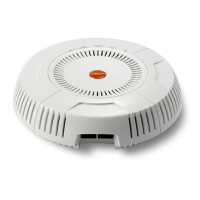Wireless Access Point
124 Viewing Status on the Wireless AP
Radio Assurance
When Radio Assurance mode is enabled, the monitor radio performs loopback
tests on the AP’s radios. When problems are encountered, the AP can take various
actions to correct them by performing different levels of reset on the affected
radio. This window shows which resets, if any, have been performed on which
radios since the last reboot.
The AP’s response to radio problems is controlled by the Radio Assurance Mode
selected, as described in “RF Resilience” on page 359. If you have selected Failure
Alerts & Repairs (with or without reboots), then the AP can take corrective action
if a problem is detected. Note that radio assurance requires RF Monitor Mode to
be enabled in Advanced RF Settings to turn on self-monitoring functions. It also
requires a radio to be set to monitoring mode. For a detailed discussion of the
operation of this feature and the types of resets performed, see “Radio Assurance”
on page 528.
Figure 69. Radio Assurance
For each of the AP’s radios, this window shows the radio’s state, its type (IEEE
802.11 type, and antenna type—2x2 or 3x3), the assigned channel, and the selected
802.11 wireless mode. To the right, the table shows counts for the number of
times, if any, that radio assurance has performed each of the following types of
resets since the last reboot, as described in Radio Assurance:
Monitor
Beacon
Phy
MAC
System (i.e., reboot the AP)

